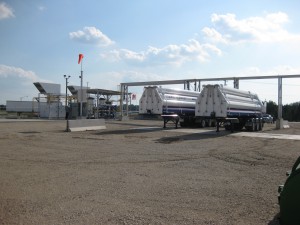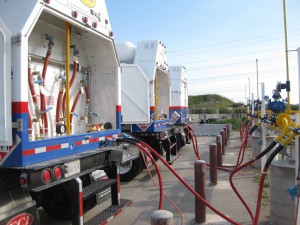February 2015, Vol. 242, No. 2
Features
Creative Responses To Provide Natural Gas

With the continuing expansion of natural gas development in shale plays across the nation, pipeline infrastructure continues to be built out, with product making the trek from source points to downstream consumers. However, not every end-user has access to affordable natural gas yet.
While the availability of natural gas from unconventional extraction has decreased utility prices at the wholesale level, end-user businesses have not necessarily seen the same drop in prices. For example, natural gas trades on the New York Mercantile Exchange for about $3.25-3.50 per Mcf. But in the middle of January 2014, as winter continued its icy march across the country, peak hourly prices in Philadelphia from city gate stations jumped to $150 per Mcf.
Prices can be as high as $11 per Mcf for end-users in pipeline-restricted regions, with many customers purchasing for about $7 per Mcf. So while purchasing natural gas on the wholesale market has proved to be extremely cost-effective, businesses and consumers buying it through standard channels have seen the effects only in stable rates rather than decreases.
Alongside lower energy prices not yet making it to consumers, pipeline infrastructure is still in the early stages of build-out from the shale plays under development. In some cases, midstream companies are using existing pipelines to transport natural gas and its products to various market regions.

In others, local opposition and intensive regulations are delaying the process to build pipelines, increasing the timeline for bringing infrastructure into operation. Thus, not all end-users have direct access from downstream operations to as much natural gas and its products as they could.
In the Northeast, where the Marcellus has seen strong production output for years, there’s a trend emerging: the virtual pipeline. Since natural gas is so plentiful in Pennsylvania, Ohio and West Virginia, some companies have capitalized on virtual pipelines to solve two challenges at once: getting more affordable natural gas to consumers and providing a new delivery method until pipeline infrastructure is available.
What’s A Virtual Pipeline?
The concept provides a direct connection for end-user businesses to receive natural gas for operations. A private, third-party entity constructs a compressed natural gas (CNG) station near a well or pipeline, then loads the CNG onto trucks and delivers it directly to users.
The third party purchases the supply directly from an exploration and production (E&P) company, and end users purchase it directly from the private, third-party business, eliminating volatile pricing and market conditions. The end-user business, often heavy industrial companies, then receives a benefit it has not yet seen – more affordable and stable natural gas prices.
Throughout last winter’s severe weather in much of the United States, many companies experienced gas supply interruptions. In some cases, this was because of voluntary participation in a peak-flow system, designed to divert energy supply away from some users to others during peak-use hours.
Over the course of a normal winter, this might occur a few times in some states. However, during the 2013-2014 winter, as the severity of temperatures and storms continued, many companies found themselves lacking the crucial energy supply needed to continue production and standard operations on a regular basis.
These companies, which include large-volume users such as manufacturers, commercial users and general-service businesses, are now exploring virtual pipeline natural gas options to remove the risk of interruptible service.
Many businesses and organizations are also looking into the possibility of lowering utility overhead costs. The cost of shipping natural gas in with diesel-fueled trucks might be a more economical choice than purchasing it from a utility supplier. Trucks transporting gas might also be powered by compressed natural gas (CNG), further lowering costs and increasing benefits.
Businesses in rural areas often lack access to natural gas. However, once utility companies construct natural gas delivery pipelines in these areas, these businesses could start receiving natural gas via virtual pipeline since CNG stations can be built nearby and the gas driven directly to their door.

How It Works
When a private company works with engineers and contractors to design, permit and construct a CNG station located near a well or pipeline, the station owner might extend the pipeline to reach its terminal. After tapping the pipeline, the gas runs through a metering system to track volume. A CNG station can likely handle 5,000-25,000 Mcf of natural gas at one time.
After passing through a dryer to remove any lingering liquids, the natural gas moves through a compressor to bring it from about 500 psi to 3,600 psi. The station tightly controls the gas temperature. Then the tube trailer is filled with gas.
The trailer contains tubes about two feet in diameter and carries 16 of these tubes in “pods.” Truck-hauling capacity is in the 350-Mcf range. The truck then delivers CNG directly to the client’s location, anywhere from down the road to 100 miles away.
Arriving at a customer’s site, the trailer connects to a decanting system. Through a thermodynamic process, the gas is reduced from the 3,600 psi to between 4-50 psi for commercial use. The trailer then remains onsite until its supply is depleted. Through a virtual monitoring system, the CNG station owner is alerted when the volume becomes low at the customer site, scheduling another trailer full of CNG to arrive as the supply is exhausted.
An end client might use several trailer loads each day or keep a trailer onsite for up to a week, depending on location and energy needs. CNG station operators can own the tractors and trailers they use for delivery, or they can lease the vehicles. Drivers might be CNG station employees or part of the trucking lease agreement.
Regardless of how the CNG station ownership and operations are structured, these projects translate to local hiring as stations and virtual pipelines are designed, constructed and maintained. These new jobs include truck drivers, compressor station operators and administrative employees.
The virtual pipeline concept is gaining traction anywhere the market advances to provide a more affordable energy source directly to consumers. Commercial businesses can look into cost comparisons as CNG stations are built in their area.
E&P companies are also showing interest in this development, especially those with a presence in rural areas. Some oil exploration companies burn excess natural gas in quantities worth millions of dollars each year, lacking the necessary infrastructure to get the byproduct to market. Installing a CNG station, or partnering with a virtual pipeline operator, could provide the opportunity for that natural gas to be used profitably while providing communities off the beaten path with a low-cost energy supply.
As the natural gas market evolves, gas companies will continue to find creative methods for getting product to market. Virtual pipelines are just one of the options assisting end-users in cost savings and stable energy supply.
Case Study
RETTEW is designing, permitting and providing construction services for the first virtual pipeline CNG station in Lycoming County, PA. This virtual pipeline will provide a route to supply Marcellus-produced gas to Pennsylvania customers faster and with less disruption than a traditional pipeline.
With a service radius of between 50-75 miles, the CNG station already has commercial customers lined up with the potential for a half dozen end-users, depending on the requested volume of supply. It will be constructed about 600 yards from an existing compressor station, with easy highway access. All tractors in use will be day-cab tractors rather than long-distance haulers and use only CNG fuel.
When completed, the CNG station will process up to 22 Mcf/d in natural gas flow to clients, with about 65 trucks delivering on a daily basis. Maximum capacity will be about three full-size truckloads each hour.
No liquids or fuels will be stored underground or onsite other than for incidental uses, such as liquid fuel needed for a lawnmower. The station’s goal is to eventually have only CNG-fueled maintenance vehicles. The layout was also designed to minimize noise and traffic to the local community – CNG tractors are about 30% quieter than similar diesel equipment. The station features enough room for trucks to safely navigate, as well as berms and plantings to fit within the surrounding area.
Emissions of a CNG tractor:
• Contains zero particulates
• Eliminates most sulfur and nitrogen oxides
• Removes almost all volatile organic compounds (VOCs)
• Reduces greenhouse gas emissions between 20-25%





Comments